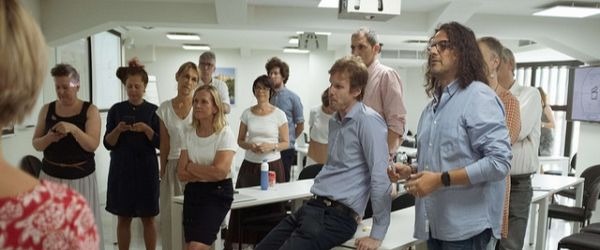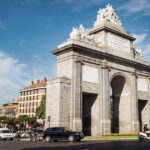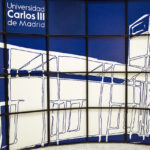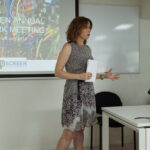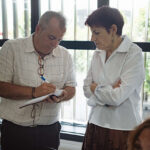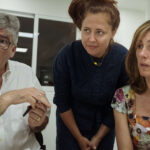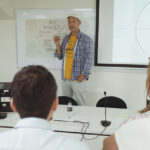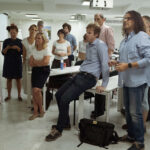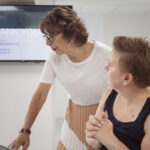On July 5 and 6, EUscreen’s network members met at Charles III University’s beautiful Puerta de Toledo Campus in Madrid. The light-induced, rationalist building stems from 1934. After having served as a fish market for decades, it opened its doors to accommodate students and faculty in 2011. Our hosts where Carmen Ciller, who coordinates the university’s film and television research group, and public broadcaster RTVE’s archive innovation team.
Spanish Video Heritage
Spain has a vibrant landscape of smaller and larger institutions that take care of the country’s audiovisual histories. The national film archive, with its Cine Doré screening room (famous for the “Shrinking Lover” scene in Pedro Almódovar’s Hable Con Ella) provided a small selection of materials to Europeana through our sister network, the European Film Gateway. The organization also collaborated with public broadcaster TVE to make the country’s rich NODO newsreel collection available through their catch-up platform A la carta.
On a regional level, there’s Catalan broadcaster TV3. While young as an institution, the organisation has been an active member of the EUscreen family for over a decade now, with over 3.000 videos on EUscreen.eu and 91.143 records linked to Europeana. Spain’s autonomous television broadcasters are united in the FORTA network, while Catalonia’s local television archives organise themselves in the “permanent observatory” OPATL. Andalucian broadcaster CanalSur provides public access to its archives by means of a curated YouTube channel and website called Memoranda.
We started off our meeting with a workshop that gave new and potential partners an overview of EUscreen’s infrastructure for publishing rich descriptions to EUscreen and Europeana. Members of the National Library, the Ministry of Agriculture, Valencian Culturarts-RTVV and Galician broadcaster CRTVG enthousiastically joined the workshop, as well as the Albanian Film Achive and the German National Library of Science and Technology. In the workshop they learned all about the Europeana metadataschema and Europeana’s data model, and aggregating via the EUscreen pipeline.
In terms of selecting content for online publication, extra attention went to the on-going Europeana Migration project, in which a group of organisations bring together selected materials. Through online exhibitions, these show how migration to, from and within Europe changed the sciences, the arts and public life throughout the ages.
Network Meeting: Use in Education and the Future of AV Tech
After the new members were joined by existing network partners over a lunch (tapas!), the group was invited to workshop the uses for audiovisual archives with Sanna Marttila from Danmark’s Technical University. As an open content advocate, Sanna worked with EUscreen in 2010, on exploring the extent to which partners’ television collections could be presented for online use. Eight years later we took the temperature again by discussing the boundaries and possibilities for using online audiovisual archive content in education and for creative use.
The workshop was a perfect segway into a panel, moderated by Sonja de Leeuw, that zoomed in on audiovisual contents in the classroom. Alex Cutajar from the European Association of History Educators (EUROCLIO) gave a passionate plea of possibilities for history teachers interacting with historical video footage. Bartolomeo Meletti from the British organisation Learning on Screen focused on the legal framework for widening options for classroom use, mirrored by ATiT’s Mathy Vanbuel, organiser of the annual Media & Learning conference, who spoke about the lack of legal clarity for teachers who aim to use media to improve learning. His talk referenced successful projects like Communia and Copyright for Creativity to activate and educate teachers and audiences about copyright. Claude Mussou, finally, gave an impressive overview of projects Ina has worked on the create educational access to their collections, including the portals Jalons and Edutheque and contextualised series such as Mystères d’Archives.
To close off this afternoon of archive uses, we turned to the technical underpinnings and how they will impact the work of audiovisual archivists across Europe and the world. Themistoklis Karavellas gave the participants a fast-paced introduction to up and coming developments such as deep learning and light-field technology.
General Assembly
EUscreen became an independent Foundation in 2015. On the Friday morning, we assembled the third General Assembly since. The Foundation Board presented updates on its strategic plan and gave an overview of on-going and upcoming projects EUscreen is involved in – such as Europeana Media.
Both the audiovisual archive and academic partners were then invited to present their public access projects. We heard from:
-
- Europeana Foundation’s Isabel Crespo on how the organisation is engaging with various educational networks and portals
-
- Austrian public broadcaster ORF, whose weekly segment Zeitreise highlights archive materials
-
- Italian public broadcaster RAI, who published its catalogue of the nation’s rich folkloric music traditions, recorded in the 1950s, online
-
- Luxemburg’s Centre national de l’audiovisuel’s participation in the country’s national digital strategy
-
- Portugal’s public broadcaster RTP’s open access archive platform, launched in 2017, with now over 33.000 items publicly available
-
- Hungary’s National Audiovisual Archive NAVA’s new platform, encouraging social interaction around audiovisual archive collections
-
- Czech Television providing access to its historical programme guide information, linked to the actual archive footage
-
- Germany’s National Library of Science and Technology’s scientific video portal, using open access licenses and services such as linked open data, stable links for permanent citability and a digital preservation approach
-
- The Albanian Film Archive’s reformatting project to serve the “Education through Culture” project
A whirlwind of projects, in all, exemplifying the breadth and progress made in providing access to once so hard to find collections. We’re already planning and looking forward to our next gathering – for the stories and exchanges, the new plans we can hatch, and admiring the progress we can make together.
Image credits: CC-BY Erwin Verbruggen

